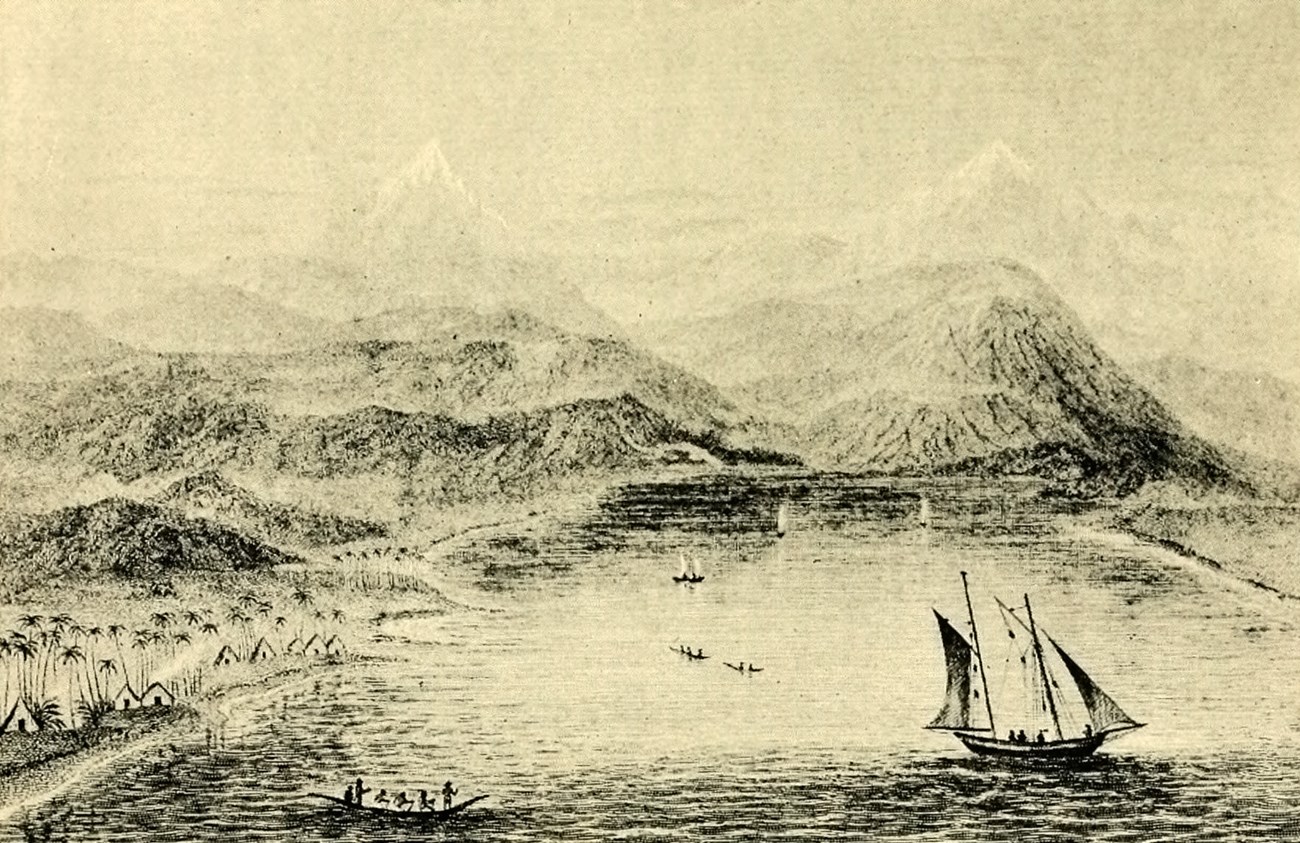Part of a series of articles titled Women's History in the Pacific West - Pacific Islands Collection.
Article
Ka‘oana‘eha

Daniel Tyerman. Originally printed in Daniel Tyerman and George Bennett, Esq., Journal of Voyages and Travels (London: Crocker and Brewster, 1832).
Ka‘ōana‘eha was born into the royal family that consolidated power over a unified Kingdom of Hawai‘i at the end of the eighteenth century, but her role in opposing Christian missionization following the collapse of the kapu (meaning both sacred and restricted) system meant that she died out of favor with her powerful family. During the height of these tensions and for years before and after, Ka‘ōana‘eha resided on grounds contained within the present-day Pu‘ukoholā Heiau National Historic Trail. The history of the names that she went by over the course of her life traces the history of that conflict: as Mele Kuamo‘o, she was linked to a pivotal battle between traditionalists and reformers; as Mary, to Christianity; and as Mrs. Young, to her diplomatic marriage to a Westerner.
Ka‘ōana‘eha was the daughter of high chief Keli‘imaika‘i (“the Good Chief,” and the younger brother of Kamehameha I) and high chiefess Kaliko‘oalani of the Mamao line of chiefs.1 Ka‘ōana‘eha’s birth around 1790 was marked by royal ceremony as the household erected pūlu‘ulo‘u or kapu sticks and beat pahu heiau or kapu drums to announce her arrival. When she was about 14 or 15, Kamehameha I arranged for his niece to marry John Young, a former British boatswain on a trading ship who became royal counselor, was conferred chiefly status, and served as governor of Hawai‘i Island (1802-1812).2 Young and Ka‘ōana‘eha settled on a homestead near Pu‘ukoholā Heiau at Kawaihae, within the current park boundary, and raised six children. Ka‘ōana‘eha lived in her own separate grass house for decades on the homestead.3 Young died in 1835.
In 1819, Ka‘ōana‘eha’s brother Kekuaokalani led a failed armed revolt against Kamehameha II, who came to the throne after the death of Kamehameha I and, together with Ka‘ahumanu (the old king’s favorite wife) as co-regent, abolished the traditional religious and political system of kapu. As the collapse of societal rules and organization following Kamehameha I’s death paved the way for Christianization, Ka‘ōana‘eha’s decision to adopt the name Kuamo‘o in memory of the battle symbolized her allegiance to the resistance.4 This name was a political embarrassment to the Christian chiefs, and so she kept her distance from them by maintaining her residence at Kawaihae.
Ka‘ōana‘eha fell ill and died at Rooke House in O‘ahu on January 22, 1850. She was buried on the Iolani Palace grounds in Honolulu without Christian funeral services, but more importantly without the high ceremony due a woman of high chiefess rank, which indicates that she was out of favor with the Honolulu chiefly circles at the end of her life. While some of her children followed the Christian religion, others followed the traditionalist path of their mother, a division that mirrored ongoing tensions in the chiefly circles between traditionalists and Christian chiefs.5 Ka‘ōana‘eha’s granddaughter Emma went on to marry Kamehameha IV, who both supported Christianity and Western values. Emma worked to bridge chiefly divisions during her time as queen, promoted education, founded the Queen’s Hospital, and argued for Hawaiian sovereignty.6
1 - Russell A. Apple, Pahukanilua: Homestead of John Young, Kawaihae, Kohala, Island of Hawai‘i (National Park Service, Hawaii State Office, 1978), 73; George S. Kanehele, Emma: Hawaii’s Remarkable Queen, A Biography (Honolulu, Hawaii: Queen Emma Foundation, 1999), 4.
2 - Kanehele, Emma, 6.
3 - Apple, Pahukanilua, 78; Kanehele, Emma, 38.
4 - Apple, Pahukanilua, 77.
5 - Kanehele, Emma, 45; Apple, Pahukanilua, 75–78.
6 - Kanehele, Emma, 378–79.
Acknowledgements:
This project was made possible in part by a grant from the National Park Foundation.This project was conducted in Partnership with the University of California Davis History Department through the Californian Cooperative Ecosystem Studies Unit, CA# P20AC00946
Last updated: February 22, 2022
